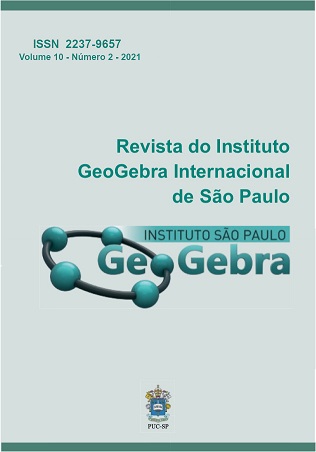Reconfiguration of polygons to determine the measurement of its area using GeoGebra software
DOI:
https://doi.org/10.23925/2237-9657.2021.v10i2p089-104Keywords:
Reconfiguration; apprehension; measurement of areas, geometry; GeoGebraAbstract
Based on the reconfiguration operation that Duval (1994) proposes for the calculation of the area measurement of a figure, this article presents a proposal to address the reconfiguration of two-dimensional figures by using GeoGebra software. In order to illustrate the relevance of the proposal in the teaching of Geometry, a study is presented with a group of sixth grade students of primary education (between 11 and 12 years of age). The results show the potential of software for the recognition of figures with the same area, the use of reconfiguration as an operation that allows to modify a figure in another, collaborative work and motivation towards mathematics. It is concluded that the proposal is a valuable contribution for the teaching of areas in Geometry.
References
Borja, I. (2015). Reconfiguración del trapecio para determinar la medida del área de dicho objeto matemático con estudiantes del segundo grado de Educación Secundaria. (Tesis de maestría). Pontificia Universidad Católica del Perú, Lima, Perú. Disponible en: http://tesis.pucp.edu.pe/repositorio/handle/123456789/6659
Castillo, M. (2018). Reconfiguración de polígonos para determinar la medida de su área con estudiantes de segundo grado de Educación Secundaria. (Tesis de maestría). Pontificia Universidad Católica del Perú, Lima, Perú. Disponible en: http://hdl.handle.net/20.500.12404/12068
Douady, R. & Perrin-Glorian, M. (1987). Un processus d’apprentissage du concept d’aire de surface plane. Cahier de didactique des mathematiques.37. IREM Université Paris 7. Disponible en: http://www.numdam.org/item/PSMIR_1987-1988___5_A3_0/
Duval, R. (1994). Les différents fonctionnements d’une figure dans une démarche géométrique. Repères-IREM, (17), pp. 121-138. Disponible en: https://publimath.univ-irem.fr/biblio/IWR97117.htm
Duval, R. (2004). Semiosis y pensamiento humano. (Myriam Vega, trad.). Cali, Colombia: Universidad del Valle, Instituto de Educación y Pedagogía, Grupo de Educación Matemática.
Duval, R. (2012a). Registro de representação semiótica e funcionamento cognitivo do pensamento. Revista electrónica de Educación Matemática: Revemat, 7(2), 266-297. Disponible en: https://doi.org/10.5007/1981-1322.2012v7n2p266
Duval, R. (2012b). Abordagem cognitiva de problema de Geometría em termos de congruencia. Revista electrónica de Educación Matemática: Revemat, 7(1), 118-138. Disponible en: https://doi.org/10.5007/1981-1322.2012v7n1p118
Duval, R. (2006). Un tema crucial en la educación matemática: La habilidad para cambiar el registro de representación. La Gaceta de la RSME, 9(1), 143-168. Disponible en: https://dialnet.unirioja.es/servlet/articulo?codigo=1984436
Herendiné, E. (2016). The level of understanding geometric measurement. Ninth Congress of the European Society of Research in Mathematics Education: CERME 9, febrero 2015, Prague, pp. 536-542.
Ferreira, L. (2010). A construção do conceito de área e da relação entre área e perímetro no 3º ciclo do ensino fundamental: estudos sob a ótica da teoria dos campos conceituais. Dissertação (Mestrado). Universidade Federal de Pernambuco. Recife, Brasil. Disponible en: https://repositorio.ufpe.br/handle/123456789/3972
Herendiné, E. (2016). The level of understanding geometric measurement. Ninth Congress of the European Society of Research in Mathematics Education: CERME 9, febrero 2015, Prague, pp. 536-542. Disponible en: https://hal.archives-ouvertes.fr/CERME9-TWG04/hal-01287005v1
Marmolejo, G. & Vega, M. (2012). La visualización en las figuras geométricas. Importancia y complejidad en su aprendizaje. Revista: Educación Matemática, 24(3), 7-32. Disponible en: http://somidem.com.mx/revista/vol24-3/
Ministerio de Educación (2015). Resolución Ministerial N° 199-2015. Lima. Disponible en: http://ccec.edu.pe/files/RM-199-2015-MINEDU-Modifica-DCN-2009.pdf
Ministerio de Educación (2016). Unidad de Medición de la Calidad. Evaluación Censal de Estudiantes 2015. Informe para docentes. Segundo grado de secundaria. Recuperado de http://umc.minedu.gob.pe/wp-content/uploads/2016/03/Informe-para-el-docente-Matem%C3%A1tica_ECE-2015.pdf
Ministerio de Educación (2017). Unidad de Medición de la Calidad. Evaluación Censal de Estudiantes 2016. Informe para docentes. Segundo grado de secundaria. Recuperado de http://umc.minedu.gob.pe/wp-content/uploads/2017/04/Informe-para-Docentes-Matem%C3%A1tica-ECE-2016-2.%C2%B0-grado-de-secundaria.pdf
Moran, M. (2016). A influência dos diferentes registros figurais nos tratamentos de figuras e mobilizações em problemas de geometria. Comunicación presentada en el I Simpósio Latino-americano de Didática da Matemática, 01-06 de noviembre. Bonito: Mato Grosso do Sul.
Ng, O. & Sinclair, N. (2015). Area Without Numbers: Using Touchscreen Dynamic Geometry to Reason About Shape, Canadian Journal of Science, Mathematics and Technology Education, (15)1, 84-101. Disponible en: https://www.tandfonline.com/doi/pdf/10.1080/14926156.2014.993048
Pessoa, G. (2010). Um estudo diagnóstico sobre o cálculo da área de figuras planas na malha quadriculada: influência de algumas variáveis. Dissertação (Mestrado). Universidade Federal de Pernambuco. Recife, Brasil. Recuperado de http://repositorio.ufpe.br/bitstream/handle/123456789/3944/arquivo61_1.pdf?sequence=1&isAllowed=y
Popoca, M. & Acuña, C. (2011). Cambios en figuras de área igual, conservación y relaciones figúrales. En P. Lestón (Ed.), Acta Latinoamericana de Matemática Educativa (24, 541-550). México, DF: Colegio Mexicano de Matemática Educativa A.C. y Comité Latinoamaricano de Matemática Educativa A.C. Recuperado de http://funes.uniandes.edu.co/4848/1/PopocaCambiosALME2011.pdf
Downloads
Published
How to Cite
Issue
Section
License
Copyright (c) 2021 Revista do Instituto GeoGebra Internacional de São Paulo

This work is licensed under a Creative Commons Attribution 4.0 International License.
Submission, processing, and publication of articles sent to the journal and registration of the DOI at Crossref is free of charge.
Authors retain their copyright and grant the journal the right of first publication of their article, which is simultaneously licensed under a Creative Commons - Attribution 4.0 International license CC BY that allows others to share the article by acknowledging its authorship and initial publication by the journal.
The GeoGebra journal encourages its authors to register their work with information and communication management systems aimed at researchers, such as Academia.edu, Mendeley, ResearchGate, etc.


 10.23925
10.23925
